|
Having trouble viewing this email? View it as a Web page.
|
|
|
|
Remarks
by Deputy Director Russ Slifer at the Patents for Humanity Awards Ceremony
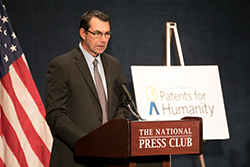 Patents
for Humanity is the USPTO’s top honor for innovators who use game-changing
technology to meet global humanitarian challenges. Businesses and others are
finding unique and creative ways to reach underserved markets. Their stories
show that humanitarian engagement is compatible with business interests and
strong patent rights, and that companies can effectively contribute to global
good while maintaining commercial markets. Patents for Humanity submissions are
evaluated on the effectiveness of their technology at addressing a humanitarian
issue, on the contributions made by applicants to increase use of their
technology among the impoverished, and on the impact those contributions have
made to improve lives.
Read the remarks by
Deputy Director Russ Slifer.
|
Remarks by
Director Michelle K. Lee at the IAM Patent Law and Policy Conference
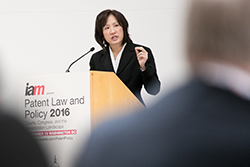 What we all know is that IP is
increasingly important to the success of our economies. That is perhaps best
illustrated in a major study on the economic impact of IP intensive industries
that was just published by the USPTO in collaboration with our DOC colleagues
at the Economics and Statistics Administration. This report found that
IP-intensive industries directly and indirectly supported more than 45 million
jobs in 2014, or nearly 1/3 of all U.S. jobs. These findings parallel the
recently released joint EPO and EUIPO study that found that approximately 38%
of all employment in EU stems from businesses that have a higher than average
use of IP rights. So, whether you’re in D.C., or London, or anywhere in between
or beyond, IP remains a vital driver of economic growth. And that is why I
believe the incoming administration must and will continue our effort to promote
innovation fueled by a strong and robust IP system. Support for IP in the
United States has a long history of bipartisanship, and there’s no reason to
imagine that changing with a new president and a new Congress, both of whom
have economic growth as a top priority.
Read the remarks by
Director Michelle K. Lee.
|
Remarks by
Director Michelle K. Lee at the Patent Subject Matter Eligibility Roundtable
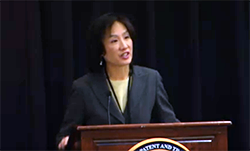 As many of you know, we’ve
already spent a fair amount of effort on this issue in recent years. Following
major court rulings, we’ve revised our examination guidance, with input from
our stakeholders, multiple times and trained our examiners on the new guidance.
For example, several Supreme Court decisions in the last few years reminded us
of the role the judicial exceptions doctrine plays in determining subject
matter eligibility. That includes the Myriad and Mayo cases, each of which
concerns the eligibility of naturally occurring things, and Alice, which
concerns the eligibility of computer-implemented inventions. Alice and Mayo
also set forth a test for evaluating the subject matter eligibility of patent
claims.
As a result of these cases, we
provided our examiners guidance that allows them to conduct complete and
thorough examinations of subject matter eligibility in accordance with the
current state of the law. In December 2014, we issued eligibility guidance that
resulted from many months of careful deliberation, including analysis of the
Supreme Court decisions and the feedback we received from our stakeholders on
the pertinent law and our pre-Alice guidance. We also held a public forum like
today’s event and solicited written comments, which we used to further refine
our guidance in July 2015 and again in May of this year. And we continued to
respond to the developing case law.
Read the remarks by
Director Michelle K. Lee.
|
USPTO Attachés: A Valuable Resource for U.S.
Intellectual Property Interests Abroad
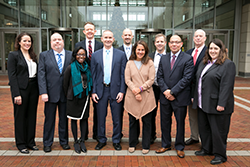 U.S. companies may
understand how to handle their intellectual property (IP) interests within the
United States, but selling products and being competitive in foreign markets
with varied and unfamiliar local IP laws is a different ball game. Independent
inventors and small and medium-sized entities may lack the in-house resources
and expertise they need to deal with foreign IP regulations.
And today, looking after those IP assets
is more important than ever: according to a recent estimate from the
International Chamber of Commerce, the global value of counterfeit and pirated
products could be as high as $1.8 trillion a year. This represents a huge loss
of revenue.
Read the blog by The Department of Commerce.
|
Results of the Post Grant Outcomes Pilot
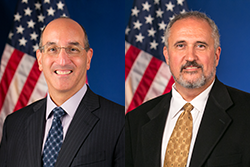 As
part of the USPTO’s ongoing Enhanced Patent Quality
Initiative, in April
2016 we launched the Post Grant Outcomes Pilot, focused on pending patent applications
that are related to issued patents undergoing an America Invents Act (AIA)
trial proceeding before the Patent Trial and
Appeal Board (PTAB). We’d like to report that the Post Grant Outcomes Pilot has
succeeded in making examiners aware of patents related to applications they are
examining that are involved in PTAB trials, and in turn has facilitated the
timely and effective examination of applications.
AIA
trial proceedings contain prior art and arguments that might be highly relevant
to the patentability determination of related applications currently under
examination. This pilot was intended to help examiners harness the art
presented during AIA trials to enhance examination of a related application, so
they could reach more expeditious decisions on patentability.
Read the blog by Chief Judge for the Patent and Trial Appeal Board David
Ruschke and Commissioner for Patents Drew Hirshfeld.
|
Optimizing Patent
Examination Time
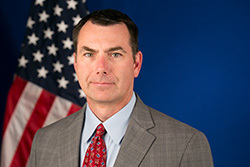 The USPTO
is committed to issuing the highest quality patents possible, as evidenced by
our Enhanced Patent Quality Initiative (EPQI). An important part of this
effort is evaluating our patent examination time goals with the help of the
public.
Examination
time goals, which vary by technology, represent the average amount of time a
patent examiner is expected to spend examining an application. Because
examination time goals impact both patent pendency and quality, we want to
ensure that our examination time goals accurately reflect the amount of time
needed by examiners to conduct quality examination. A critical part of our
efforts is obtaining stakeholder input.
Read the blog by Deputy Director Russ Slifer.
|
New Trademark App Open Source Code on Github
 Improving the way the government delivers information technology (IT) solutions
to its customers isn’t just a goal, it’s our mission. We at the U.S. Patent and
Trademark Office know that by publishing our open source code, the public can
help us come up with new and better IT solutions. In advance of the new Federal Source Code Policy and in support
of the Administration’s Open Government Initiative, we have been
publishing content on Github for over a year, and it now
includes source code for a mobile application for trademarks.
The new published source code on Github is for a sample application enabling a
user to access and track the status of a trademark. This application enables
the user to receive a push notification anytime the status of a trademark
application changes. The idea for this app began with feedback from the
leadership in Trademarks, and we believe that it will also be a useful tool for
our own employees. We’re making our code for this application open to the
public, so you can also use it in your own projects, improve it so it works
best for you, or create an entirely new application.
Read the blog by Chief Technology Officer David Chiles.
|
Celebrating Veterans at the USPTO
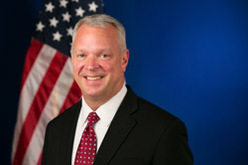 “Eternal vigilance
is the price of liberty,” Thomas Jefferson once wrote.
In the United
States that price has been paid by generations of veterans at home and abroad,
in peacetime and war – selfless citizens who have sacrificed their time,
comfort, and even their lives in defense of our nation and our allies.
At the United
States Patent and Trademark Office (USPTO) today, we are privileged to have
many such veterans among us. Some have served in places like Iraq, Afghanistan,
the Balkans, and Vietnam. Some are serving still, in the reserves, attending
monthly drills and annual training and deploying into harm’s way when needed.
also use it in your own projects, improve it so it works best for you,
or create an entirely new application.
Read the blog by Chief Administrative Officer Fred Steckler.
|
Collegiate Inventors Competition Showcases Tomorrow’s
Entrepreneurs
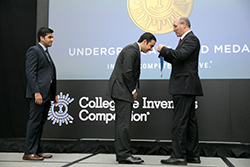 Standing on stage
this past Friday, inventors from colleges and universities across the country
were recognized for their work developing cutting-edge inventions, at the
2016 Collegiate Inventors
Competition (CIC) at the U.S.
Patent and Trademark Office (USPTO) in Alexandria, VA. Through CIC, the skills
that these students have gained both through the process of invention and by
learning about intellectual property will be an asset to them as they decide on
their next steps, which could be further research or commercializing their
invention. “The ideas represented in this room—and the bright minds behind
them—are the present and future of America innovation,” said Drew Hirshfeld,
Commissioner for Patents at the USPTO.
The 28
undergraduate and graduate students all had the chance to interact one-on-one
with inductees of the National Inventors Hall of
Fame (NIHF). These established
inventors – who have invented many tools, processes, or devices that are now
commonplace in our lives, such as the digital camera, microprocessor, electret
microphone, and the implantable defibrillator – served as judges for the
competition and provided advice and inspiration for the students. USPTO
officials and AbbVie Foundation scientists also served as judges.
Read the blog by The Department of Commerce.
|
Results of the Clarity of the Record Pilot
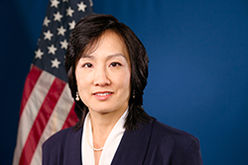 I’m pleased to report that we have completed the Clarity of the Record Pilot launched earlier this year as part of our Enhanced Patent Quality
Initiative. We’ve achieved our goal
of identifying some best practices for enhancing the clarity of various aspects
of the prosecution record. These include best practices for documenting the
USPTO’s positions with respect to claim interpretation, reasons for allowance,
and interview summaries as well as encouraging examiners to initiate pre-search
interviews when needed to gain a better understanding of the claimed invention.
I would like to fill you in on some of our findings, and also encourage you to
attend our day-long patent quality conference on December 13, where we will report in detail
on the progress of the dozen or so programs in the Enhanced Patent Quality Initiative.
Read the blog by Director Michelle K. Lee.
|
IT Innovation at the USPTO in 2016
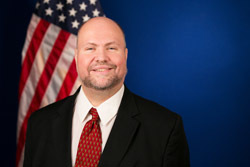 As the year comes to a close, it is a perfect
time to reflect on our current successes, and challenge ourselves to
continually improve our information technology (IT) systems. As the Chief Information
Officer, I am focused on driving innovation at the USPTO while protecting our
nation’s cutting edge ideas.
The Office of the Chief Information Officer
(OCIO) works hard every day to make sure both our existing systems and our new
“next generation” systems enable examiners to accomplish their important work.
We are building excellent tools for the public while we drive to fine-tune our
own processes for greater efficiency. Supported by more robust, updated IT
systems and tools, USPTO examiners will be able to leverage these tools, and
new data, to issue the best quality patents and trademarks. When we
improve systems and services for our examiners, the public benefits as well.
Read the blog by Chief Information Officer John Owens II.
|
Enhancements
to Trademark Trial and Appeal Board Proceedings
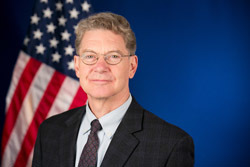 The Trademark Trial and Appeal Board (TTAB)
announced the culmination of an in-depth outreach effort to stakeholders focused
on enhancing the Board’s appeal and trial processes. In a Notice
of Final Rule-Making (NFRM), published in the Federal Register on October 7,
2016, the USPTO said new rule changes
will benefit the public by providing more clarity in the rules, flexibility for
parties involved in Board proceedings, and increased procedural efficiency. At
the same time, the rules further a USPTO strategic objective to increase end-to-end
electronic processing of trademark matters, which reduce costs to the USPTO and
the public, and helps avoid errors that may creep into records during manual
entry of data contained in paper filings.
The last major set of TTAB rule changes took
effect in 2007. Since then, there have been case law developments, changes in
the Federal Rules of Civil Procedure, and the rollout of the USPTO’s
Accelerated Case Resolution (ACR) process. Therefore, it is an ideal time to
update the rules to make the benefits of ACR available to all parties, as well
as to promote electronic filing and communication. The rule changes, major
provisions of which are summarized below, reflect significant input from the
Trademark Public Advisory Committee, individual stakeholders, and professional
associations, and have been well-received since publication in the Federal
Register.
Read the blog by Chief Administrative Trademark Judge Gerard F. Rogers.
|
Patent Subject-Matter Eligibility: Roundtable 1
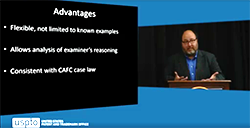 Over the past six years, the U.S. Supreme Court has issued a
series of decisions—Bilski, Mayo, Myriad, and Alice—that have significantly impacted patent eligibility law and
continue to generate substantial public debate. The USPTO sought input from the
public on patent subject-matter eligibility through the first of two
roundtables November 14 in Alexandria, Virginia.
This first roundtable focused on soliciting stakeholder views on
ways of improving the USPTO’s subject-matter eligibility guidance for patent
examiners and how that guidance is being applied by examiners. Additional
details about the roundtables are in a Federal
Register Notice published October 17,
2016.
To learn more, watch the archived video.
|
Patent Quality Chat – Clarity of the Record Pilot: A
Discussion of Findings
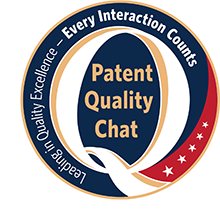 The Deputy Commissioner for Patent Quality held the twelfth Patent
Quality Chat in the 2016 webinar series on Tuesday, November 8th on
our Clarity of the Record Pilot.
Director of Technology Center 2800 Robin Evans
and Acting Director of the Office of Patent Quality Assurance Marty Rater
discussed the construction of the pilot and our findings. We invite all
attendees to listen in and provide your feedback on what we have identified as
key drivers of patent quality. Improving the clarity of the patent prosecution
record is an important step toward enhancing our Excellence in Work Products as
a part of the Enhanced Patent Quality Initiative
(EPQI) and maintaining high
patent quality moving forward.
Patent Quality Chat is a monthly, lunchtime webinar series designed to provide
information on patent quality topics and gather your input. The last
Patent Quality Chat of 2016 will be held on December 13 and will be a special
engagement on advancing patent quality across the IP community, featuring
Director Michelle K. Lee.
To learn more about the November Patent
Quality Chat, watch the archived video or view the presentation slides.
|
2016 Collegiate Inventors Competition Expo and Awards
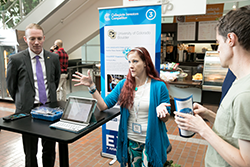 The Collegiate
Inventors Competition, a program of the National
Inventors Hall of Fame in partnership with the USPTO, is an annual competition
that rewards innovations, discoveries, and research by college and university
students and their faculty advisors. The 2016 finalists and their inventions
provided a glimpse into the future of American innovation and emerging
technological trends, from advanced crop harvesting techniques to medical
breakthroughs designed to help people in low- to middle-income countries.
Eleven competition finalists showcased their inventions and interacted with thousands of
USPTO patent and trademark examiners, sponsors, media, and the public at the
Collegiate Inventors Competition Expo.
To learn more about the finalists, visit
the Collegiate
Inventors Competition website.
|
Patent Public Advisory Committee
Quarterly Meeting
|
|
|
|
|
|
|
Stay connected with the USPTO by subscribing to regular email updates.
Visit our subscription center at www.uspto.gov/subscribe to update or change your email preferences.
This email was sent from an unmonitored mailbox. To contact us, please visit our website www.uspto.gov/about/contacts. To ensure that you continue to receive our news and notices, please modify your email filters to allow mail from subscriptioncenter@subscriptions.uspto.gov.
|
|
|
|
|
|